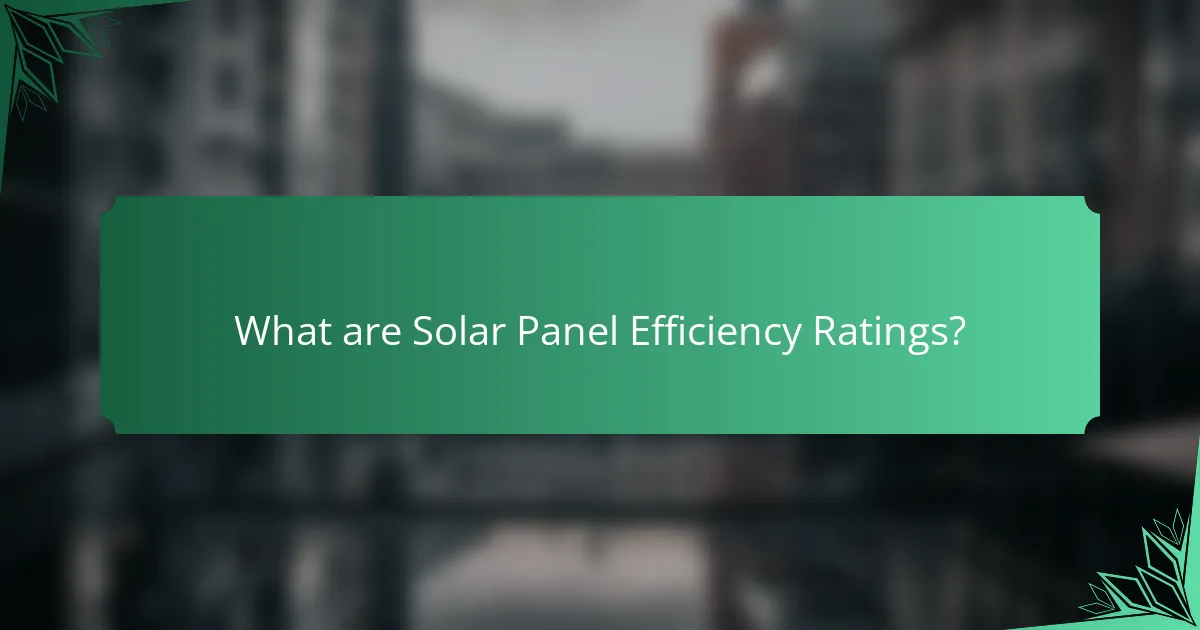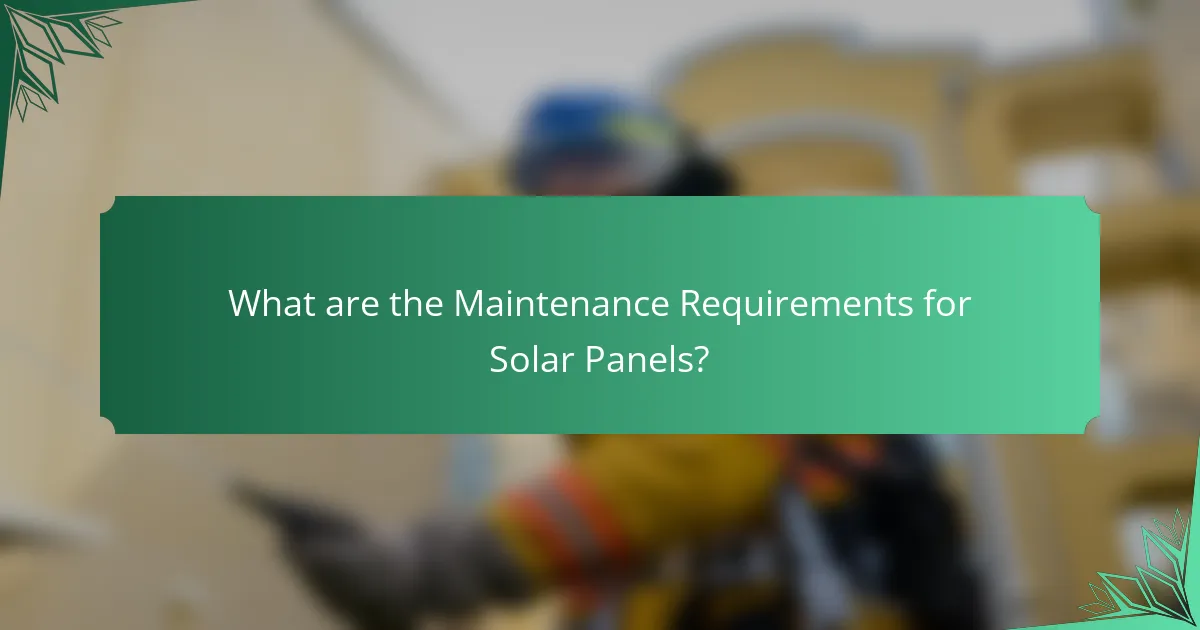
What are Solar Panel Efficiency Ratings?
Solar panel efficiency ratings indicate how effectively a solar panel converts sunlight into electricity. These ratings are typically expressed as a percentage. For example, a panel with a 20% efficiency rating converts 20% of the sunlight it receives into usable electricity. Higher efficiency ratings mean more electricity generation for the same amount of sunlight. Most modern solar panels have efficiency ratings ranging from 15% to 22%. Factors affecting efficiency include the type of solar cells used and the design of the panel. The efficiency rating is crucial for determining the overall performance and energy output of a solar panel system.
How are Solar Panel Efficiency Ratings measured?
Solar panel efficiency ratings are measured by determining the ratio of electrical output to the solar energy input. This is typically expressed as a percentage. To measure efficiency, standardized testing conditions are applied, usually under full sun at 1000 watts per square meter. The testing evaluates how much sunlight the panel converts into usable electricity. The results are compared to the theoretical maximum output. Additionally, the performance may be assessed over time under varying environmental conditions. The efficiency ratings provide a metric for consumers to evaluate and compare different solar panels.
What standard tests are used to determine efficiency?
Standard tests used to determine solar panel efficiency include the Standard Test Conditions (STC) test, the Temperature Coefficient test, and the Performance Ratio test. The STC test measures a panel’s output under specific conditions: 1000 W/m² solar irradiance, 25°C temperature, and air mass of 1.5. This test provides a baseline efficiency rating for comparison. The Temperature Coefficient test assesses how efficiency changes with temperature variations, indicating performance in real-world conditions. The Performance Ratio test evaluates the actual output of a solar panel compared to its expected output, accounting for losses due to inefficiencies. These tests are widely recognized and provide essential data for consumers and manufacturers.
How do environmental conditions affect efficiency ratings?
Environmental conditions significantly impact solar panel efficiency ratings. Factors such as temperature, shading, and humidity directly influence energy output. Higher temperatures can reduce efficiency, as most solar panels perform optimally at cooler temperatures. Shading from trees or buildings can obstruct sunlight, leading to decreased power generation. High humidity can also affect performance, as moisture may lead to increased resistance in the solar cells. According to the National Renewable Energy Laboratory, solar panels can lose up to 20% of their efficiency due to temperature increases beyond optimal levels. Therefore, understanding these environmental factors is crucial for accurate efficiency ratings.
Why are Solar Panel Efficiency Ratings important?
Solar panel efficiency ratings are important because they indicate how effectively a solar panel converts sunlight into electricity. Higher efficiency ratings mean more energy production from the same amount of sunlight. This is crucial for maximizing energy output, especially in limited space. For instance, a panel with a 20% efficiency rating generates more power than one with a 15% rating under identical conditions. Additionally, efficiency ratings help consumers compare products and make informed purchasing decisions. They also influence the overall return on investment for solar energy systems. Therefore, understanding efficiency ratings is essential for optimizing solar energy use.
How do efficiency ratings influence energy production?
Efficiency ratings directly impact energy production by indicating how effectively a solar panel converts sunlight into electricity. Higher efficiency ratings mean more energy output per square meter of panel. For example, a solar panel with a 20% efficiency rating generates more electricity than one with a 15% rating under the same conditions. This directly influences the overall energy yield of a solar installation. Increased efficiency reduces the space needed for solar panels to achieve desired energy production levels. Additionally, higher efficiency can lead to lower costs per watt of energy produced over time. Thus, efficiency ratings are critical in determining the performance and economic viability of solar energy systems.
What role do efficiency ratings play in consumer choice?
Efficiency ratings significantly influence consumer choice in solar panels. These ratings indicate how effectively a solar panel converts sunlight into electricity. Higher efficiency ratings often lead to greater energy output for the same surface area. Consumers tend to prefer panels with higher efficiency ratings to maximize energy production and minimize space usage. Research shows that consumers are willing to pay a premium for panels with better efficiency ratings. For instance, a study by the National Renewable Energy Laboratory found that higher efficiency panels can generate up to 20% more energy over their lifetime. This increased energy production can lead to higher savings on electricity bills, making efficiency ratings a critical factor in purchasing decisions.

What are the Maintenance Requirements for Solar Panels?
Solar panels require minimal maintenance to operate efficiently. Regular cleaning is essential to remove dirt and debris. This cleaning can be done with water and a soft brush. Inspecting the panels for any physical damage is also necessary. Checking the electrical connections helps ensure proper functioning. Monitoring the inverter’s performance is crucial for identifying issues. Professional inspections are recommended every few years. These practices can enhance the lifespan and efficiency of the solar panels. Regular maintenance can increase energy production by up to 20%.
How often should Solar Panels be maintained?
Solar panels should be maintained at least once or twice a year. Regular maintenance ensures optimal performance and longevity. This includes cleaning the panels and checking for any damage. Dust, dirt, and debris can reduce efficiency. Inspecting connections and wiring is also crucial. Annual professional inspections can identify potential issues early. According to the U.S. Department of Energy, proper maintenance can extend the lifespan of solar panels. Most solar panels have a lifespan of 25 years or more with adequate care.
What routine checks are essential for solar panel maintenance?
Routine checks essential for solar panel maintenance include inspecting for dirt and debris. Clean solar panels can improve efficiency by up to 20%. Additionally, checking for shading from nearby trees or buildings is crucial. Regularly monitoring the inverter’s performance ensures the system is functioning correctly. Inspecting wiring for wear or damage prevents potential hazards. Finally, reviewing the overall structural integrity of the mounting system is important for safety. These checks collectively help maintain optimal solar panel performance and longevity.
How can weather conditions impact maintenance frequency?
Weather conditions significantly impact maintenance frequency for solar panels. Extreme weather events, such as heavy rain, snow, or dust storms, can lead to increased debris accumulation. This debris can obstruct sunlight and reduce efficiency. Additionally, high humidity can promote mold growth on panels, necessitating more frequent cleaning.
In regions with frequent storms, inspections may need to occur after each event to assess potential damage. Conversely, mild weather may allow for less frequent maintenance. Research indicates that solar panels in areas with high dust levels require cleaning every few weeks, while those in cleaner environments may need maintenance only a few times a year.
Overall, the specific local climate directly influences how often solar panels require maintenance to ensure optimal performance.
What common maintenance tasks are required for Solar Panels?
Common maintenance tasks for solar panels include regular cleaning, inspection, and monitoring. Cleaning involves removing dirt, dust, and debris to ensure optimal performance. Inspections should be conducted periodically to check for any physical damage or wear. Monitoring the system’s performance helps identify any issues early on. These tasks are essential for maintaining efficiency and longevity. According to the U.S. Department of Energy, proper maintenance can increase a solar panel’s lifespan and efficiency. Regular upkeep can prevent costly repairs and ensure the system operates at peak performance.
How do you clean Solar Panels effectively?
To clean solar panels effectively, use a soft brush or sponge with mild soap and water. Avoid abrasive materials that can scratch the surface. Rinse the panels thoroughly with clean water to remove any soap residue. For stubborn dirt, consider using a mixture of vinegar and water. Cleaning should be done early in the morning or late in the afternoon to avoid heat stress. Regular cleaning can enhance efficiency by up to 20%, as dirt and debris can block sunlight.
What should be inspected during a maintenance check?
During a maintenance check, solar panels should be inspected for physical damage, dirt accumulation, and electrical connections. Physical damage includes cracks or chips in the panels. Dirt accumulation can significantly reduce efficiency by blocking sunlight. Electrical connections must be checked for corrosion or loose wiring. Inverter functionality should also be assessed, as it converts solar energy into usable power. Additionally, the mounting system should be inspected for stability and security. Regular inspections can enhance the longevity and efficiency of solar panels. These checks help ensure optimal performance and early detection of potential issues.

What are the Longevity Expectations for Solar Panels?
Solar panels typically have a longevity expectation of 25 to 30 years. Most manufacturers provide warranties ranging from 20 to 25 years. During this period, solar panels can maintain 80% or more of their original efficiency. Studies indicate that degradation rates average about 0.5% to 1% per year. This means that after 25 years, a solar panel may still produce 75% to 90% of its initial output. Regular maintenance can further enhance their lifespan. Factors like installation quality and environmental conditions also play significant roles in longevity.
How long can Solar Panels typically last?
Solar panels typically last between 25 to 30 years. Most manufacturers provide warranties that cover this duration. After 25 years, solar panels may still operate at about 80% efficiency. Research indicates that the degradation rate is approximately 0.5% to 1% per year. This means that solar panels lose their efficiency gradually over time. Regular maintenance can help prolong their lifespan. Factors such as weather conditions and installation quality also play a significant role in longevity.
What factors contribute to the lifespan of Solar Panels?
The lifespan of solar panels is influenced by several key factors. These factors include the quality of materials used, installation methods, and environmental conditions. High-quality solar panels typically last longer than cheaper alternatives. Proper installation ensures optimal performance and reduces the risk of damage. Environmental factors such as temperature, humidity, and exposure to UV rays can affect durability. Regular maintenance, including cleaning and inspections, can also extend the lifespan. Research indicates that most solar panels have a lifespan of 25 to 30 years, with performance warranties often covering this period.
How do different types of solar panels compare in longevity?
Monocrystalline solar panels typically last 25 to 30 years. They have a high efficiency and lower degradation rate. Polycrystalline panels generally last 20 to 25 years. Their efficiency is slightly lower than monocrystalline panels. Thin-film solar panels have a shorter lifespan, usually around 10 to 20 years. They are less efficient but lighter and flexible. Longevity is influenced by factors like environmental conditions and installation quality. Monocrystalline panels often have warranties of 25 years or more, indicating their durability. Polycrystalline panels also offer warranties, but they may be shorter than those of monocrystalline panels.
What can affect the longevity of Solar Panels?
The longevity of solar panels can be affected by several factors. Environmental conditions play a significant role. High temperatures can reduce efficiency and lifespan. Similarly, extreme weather events like hail or heavy snow can cause physical damage. Quality of materials used in manufacturing also impacts durability. Lower-quality panels may degrade faster over time. Regular maintenance is crucial for extending lifespan. Dust and debris accumulation can hinder performance. Proper installation ensures optimal functioning and longevity. Research indicates that well-maintained solar panels can last over 25 years.
How does installation quality impact solar panel lifespan?
Installation quality significantly impacts solar panel lifespan. Proper installation ensures that panels are securely mounted and optimally positioned. This prevents physical damage from wind or debris. Additionally, high-quality electrical connections reduce the risk of overheating. Poor installation can lead to moisture ingress, which damages internal components. Research indicates that professionally installed solar panels can last 25 years or more. In contrast, poorly installed systems may fail within a decade. Therefore, installation quality is crucial for maximizing the longevity of solar panels.
What role does regular maintenance play in extending longevity?
Regular maintenance plays a crucial role in extending the longevity of solar panels. It ensures optimal performance and prevents issues that could lead to degradation. Routine cleaning removes dirt and debris, which can block sunlight and reduce efficiency. Inspections identify potential problems such as loose connections or damaged components. Addressing these issues promptly helps avoid more significant failures. Research indicates that well-maintained solar panels can last 25 years or more. In contrast, neglecting maintenance can shorten their lifespan significantly. Regular maintenance thus directly correlates with enhanced durability and efficiency.
What are the best practices for maximizing Solar Panel efficiency, maintenance, and longevity?
To maximize solar panel efficiency, maintenance, and longevity, regular cleaning is essential. Dust and debris can significantly reduce energy output. It is recommended to clean panels at least twice a year. Additionally, ensuring proper installation angles optimizes sunlight exposure. Panels should ideally face south in the northern hemisphere.
Monitoring system performance is crucial. Regular checks can identify underperformance issues early. Furthermore, keeping the surrounding area clear of obstructions enhances efficiency. Shade from trees or buildings should be minimized.
Conducting professional inspections annually is advisable. Experts can detect potential issues and recommend repairs. Finally, using high-quality materials during installation contributes to longevity. Quality panels typically have warranties of 25 years or more.
Solar panel efficiency ratings measure how effectively solar panels convert sunlight into electricity, typically expressed as a percentage. This article covers the factors influencing these ratings, the standard tests used for measurement, and the impact of environmental conditions on efficiency. Additionally, it discusses the maintenance requirements for solar panels, including routine checks and cleaning practices necessary for optimal performance. Lastly, the article addresses the longevity expectations of solar panels, detailing the factors that contribute to their lifespan and best practices for maximizing efficiency and durability.